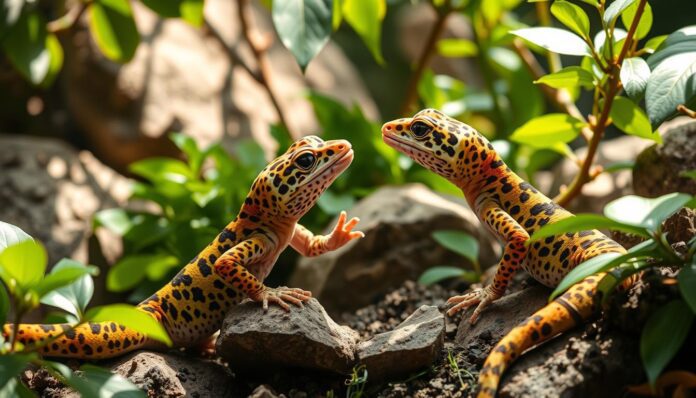When Do Leopard Geckos Lay Eggs?
Did you know a single female leopard gecko can lay up to 20 eggs in one breeding season? These amazing reptiles come from the dry lands of Pakistan and India. They are known for their stunning colors and can live over 20 years in captivity. Learning about their breeding and egg-laying is key for any fan.
Leopard geckos usually breed from January to September. Most of their breeding happens between January and March. Females can lay eggs 2-5 weeks after mating. Each clutch has 2 eggs, but this number can change.
First-time or older females might lay only 1-2 clutches a season. But, experienced breeders can have up to 10 or more clutches.
Understanding Leopard Gecko Breeding Basics
Breeding leopard geckos needs a deep understanding of their unique body and breeding habits. Knowing when they are ready and the best conditions for breeding is key. These factors are important for a successful leopard gecko breeding journey.
Sexual Maturity and Size Requirements
Female leopard geckos are ready to breed when they weigh about 45 grams and are 9 to 10 months old. Male leopard geckos are ready when they have a bulge at the base of their tail and large, dark pores. Females don’t have these signs or have them less.
Male vs. Female Physical Characteristics
Knowing a leopard gecko‘s gender is important for breeding. Males are bigger, growing up to 12 inches long. Females are smaller, between 7 to 10 inches. A bulge at the tail and big pores are signs of a male leopard gecko.
Optimal Breeding Age and Conditions
For the best breeding results, leopard geckos should be at least 1 year old and fully grown. They must be healthy and have enough fat. Breeding happens when it’s warmer and days are longer, from January to September.
Preparing Your Leopard Geckos for Breeding Season
leopard gecko breeding season-As the breeding season gets closer, it’s key to get your leopard geckos ready. Many breeders start cooling them down in November or December. They lower the warm spot’s temperature from 88°F to 65°F over weeks.
Cooling isn’t needed for breeding, but it helps healthy leopard gecko breeding season. It’s important to give them more food and calcium, mainly to females. This ensures they’re healthy for breeding. Also, keep a calcium dish in their enclosure all year for their reproductive health.
| Characteristic | Measurement |
|---|---|
| Male Leopard Gecko Size | 10 to 12 inches long |
| Female Leopard Gecko Size | 7 to 10 inches long |
| Leopard Gecko Lifespan | More than 20 years |
By following these steps, you’ll get your leopard geckos ready for breeding. Focus on their environment and diet. This will keep them healthy and ready for breeding.
When Do Leopard Geckos Lay Eggs?
Leopard geckos are loved by many reptile fans. Knowing when they lay eggs is key for good care. This question helps owners give the best home for these amazing animals.
Breeding Season Timeline
In the northern hemisphere, leopard geckos breed from January to September. leopard gecko breeding season Female geckos lay one or two eggs at a time. The whole process starts with the male and female showing courtship and mating.
Frequency of Egg Laying
After mating, females lay their first eggs in 16-22 days. They can lay more eggs every 15-22 days, up to 100 times in their life. Some females lay one egg, others two.
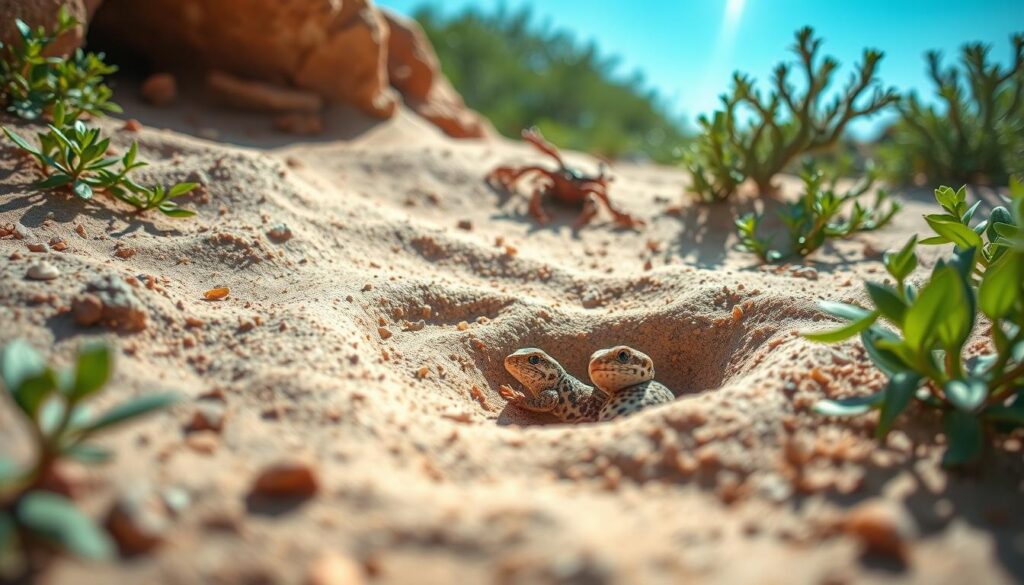
Signs of Upcoming Egg Laying
Before laying eggs, females show clear signs. Their skin bulges with eggs. They also become less active and start digging. They might stop eating for a week before laying.
Knowing when and how often leopard geckos lay eggs is vital. It helps keep them healthy and happy during breeding season.
Creating the Perfect Egg-Laying Environment
Creating the right environment is key for leopard geckos to lay eggs well. Start by setting up a dedicated nesting box. It should be about 6-7 inches wide and 4 inches tall. Use a moist substrate like peat moss or Bed-A-Beast litter.
For more than one female, a plastic shoebox works great. Cut a 2-inch hole in the lid for easy access.
The substrate should feel like fresh earth but not be too wet. Place the box in a quiet spot in the enclosure. This leopard gecko egg laying environment is perfect for egg-laying.
Also, keep the enclosure temperature right for your geckos. For females, it should be between 79-82°F. For male geckos, use an incubator at 87-88°F.
With the right leopard gecko nesting box and environment, you’ll have a great breeding season.
| Substrate | Temperature | Incubator Model |
|---|---|---|
| Peat moss, vermiculite, or Bed-A-Beast litter | 79-82°F for females, 87-88°F for males | Hova-Bator Standard View Thermal Air Flow Hova-Bator Model# 1602R |
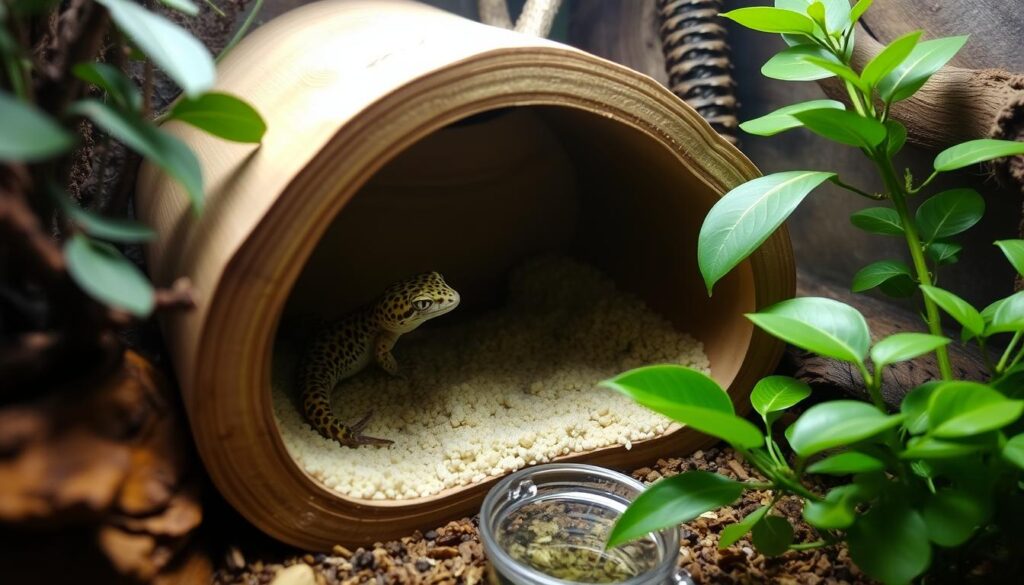
The Egg-Laying Process
Understanding the leopard gecko egg-laying process is key. when do leopard geckos lay eggs? Knowing about pre-laying behavior, care during and after laying, and possible complications is important. This knowledge helps ensure a successful breeding season.
Pre-laying Behavior
As the breeding season nears, female leopard geckos show unique behaviors. They dig in the substrate, looking for the best spot to lay eggs. They also eat less in the days before laying eggs.
During and After Laying Care
Leopard geckos might lay eggs in a nesting box or other places like water bowls. After laying, it’s important to give the female more food and calcium. This helps her recover from the egg-laying process. Watching her health closely is vital during this time.
Common Complications
- Egg Binding: Egg binding is a serious issue where the female can’t lay eggs. It’s a life-threatening problem that needs immediate vet care.
- Infertile Eggs: Bad nutrition can cause infertile eggs. These eggs won’t hatch. Proper nutrition is essential to avoid this.
- Inexperienced Breeders: New breeders might face issues with eggs not incubating well. They need extra care and attention.
Keeping a close eye on the female leopard gecko’s health and behavior is critical. By understanding the leopard gecko egg laying process and being ready for leopard gecko laying complications, you can ensure the well-being of your breeding pair and their babies.
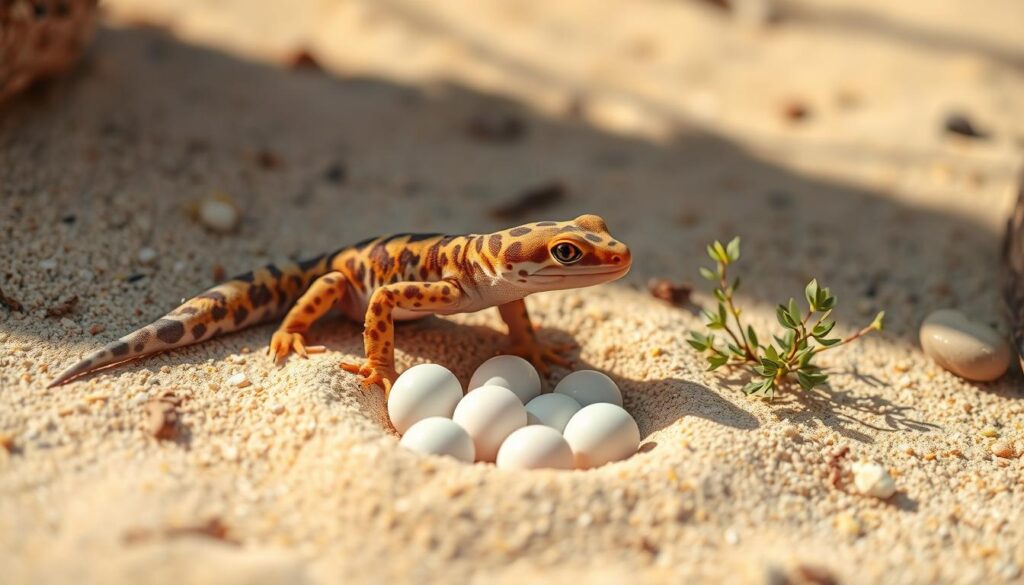
Essential Care for Gravid Females
Caring for gravid (egg-bearing) female leopard geckos is key during breeding season. They need extra care and a special environment for their eggs to develop well.
First, give them a calcium-rich diet. Dust their food with a good calcium supplement. Also, have a calcium dish in their enclosure for extra calcium.
Feed them more often and in larger amounts. They need more food to support their eggs. Watch their weight and adjust their food as needed.
Keep the enclosure warm, with a spot between 86-90°F. This helps the eggs grow. Make sure they have a humid hide box for shedding and egg support.
| Gravid Leopard Gecko Care Checklist |
|---|
|
Keep a close eye on the gravid female’s weight and overall health. This ensures she gets the care she needs to lay healthy eggs. Good care is essential for a successful breeding program.
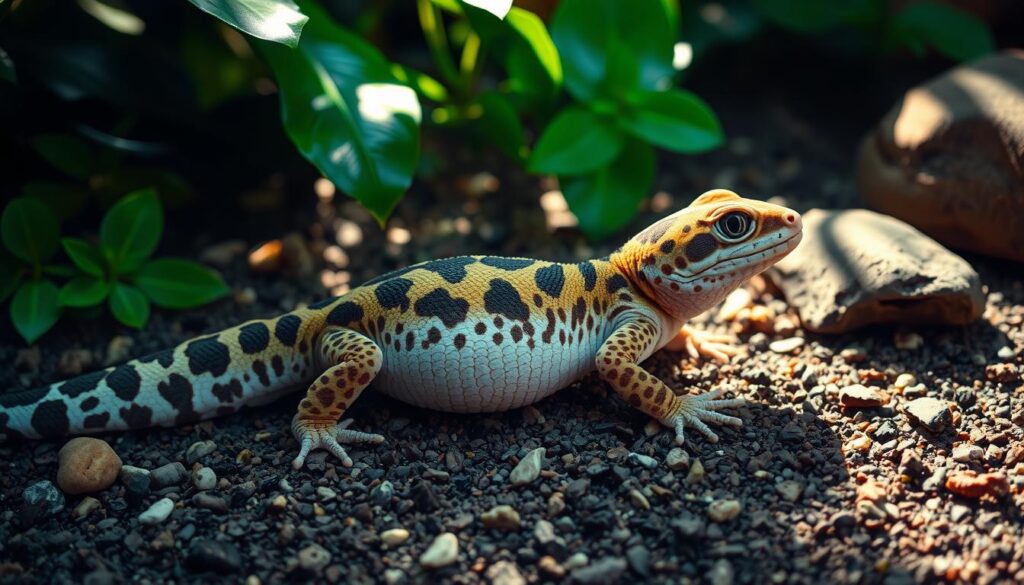
Proper Egg Incubation Techniques
Successful leopard gecko breeding needs the right egg incubation. The temperature and humidity must be just right. This is key for the eggs to grow well and for the hatchlings’ sex to be determined.
By mastering leopard gecko egg incubation, breeders can get a high hatching rate. They can also ensure their hatchlings are healthy and diverse.
Temperature Control and Sex Determination
The incubation temperature is key in deciding the hatchlings’ sex. At 80°F, most eggs will hatch female geckos. Raising the temperature to 87°F will give a mix of males and females.
At 90°F, mostly male hatchlings are expected. Keeping the temperature steady is vital for the right sex ratio.
Humidity Requirements
Proper humidity is as important as temperature in leopard gecko egg incubation. The eggs need to be in a mix of vermiculite or perlite and water. This mix keeps the humidity high for growth, without the eggs getting wet.
Incubation Duration
The incubation time varies with temperature. At 81-83°F, eggs hatch in about 65 days, mostly females. At 84-86°F, they hatch in 55 days, with a mix of sexes.
At 87-89°F, eggs hatch in 40 days, mostly males. Breeders must watch the incubation closely and adjust the temperature as needed.
| Incubation Temperature | Incubation Duration | Sex Ratio |
|---|---|---|
| 81-83°F | ~65 days | Mostly females |
| 84-86°F | ~55 days | Mix of males and females |
| 87-89°F | ~40 days | Mostly males |
For successful breeding, leopard gecko egg incubation is key. It includes controlling temperature, maintaining humidity, and monitoring incubation time. By understanding these factors, breeders can increase their chances of healthy, diverse leopard gecko offspring.
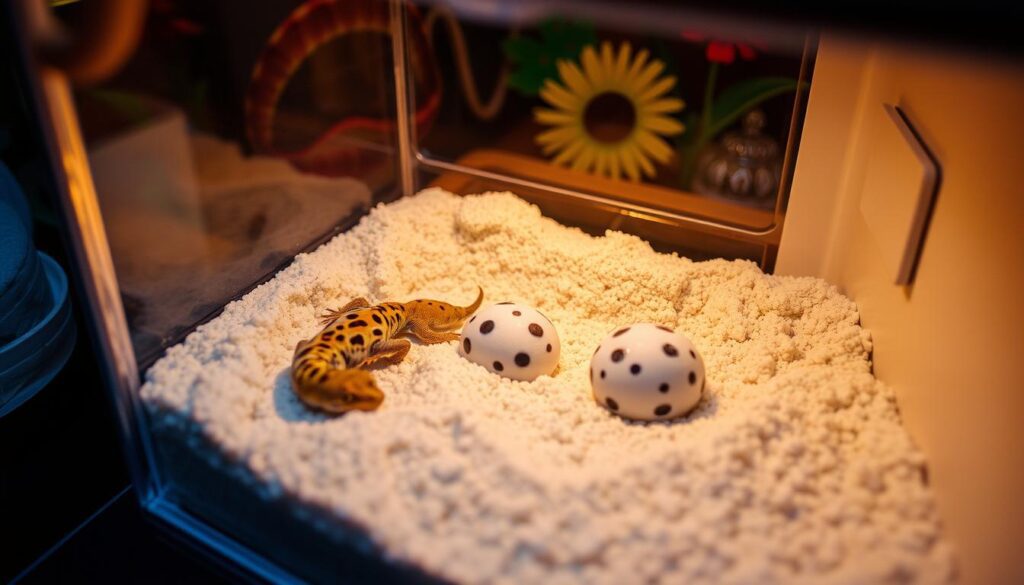
Common Breeding Challenges and Solutions
Leopard gecko breeding can face many challenges, like infertile eggs and weak babies. It’s key to know why these problems happen and how to fix them.
Leopard gecko egg infertility often comes from bad food and not enough calcium. Giving your breeding geckos the right food and calcium can solve this.
Egg binding is when a female leopard gecko can’t lay eggs. She might look tired or show other signs of trouble. If you think this is happening, get her to a vet fast. It’s very serious.
| Breeding Challenge | Causes | Solutions |
|---|---|---|
| Infertile Eggs | Improper nutrition, lack of calcium | Provide a balanced diet and calcium supplements |
| Egg Binding | Stress, improper environment | Seek veterinary care, optimize enclosure conditions |
| Weak Offspring | Incubation issues, genetic factors | Maintain optimal incubation temperature and humidity |
Also, leopard gecko breeding problems can come from aggressive males or stressed females. Keeping them apart and making a calm place for them can help.
By tackling these common issues and using good solutions, leopard gecko breeders can have more success and healthy babies.
Conclusion
Breeding leopard geckos needs a deep understanding of their cycle and care for pregnant females. It also requires mastering incubation. Successful egg laying means being prepared, paying attention to details, and ensuring the best conditions for all.
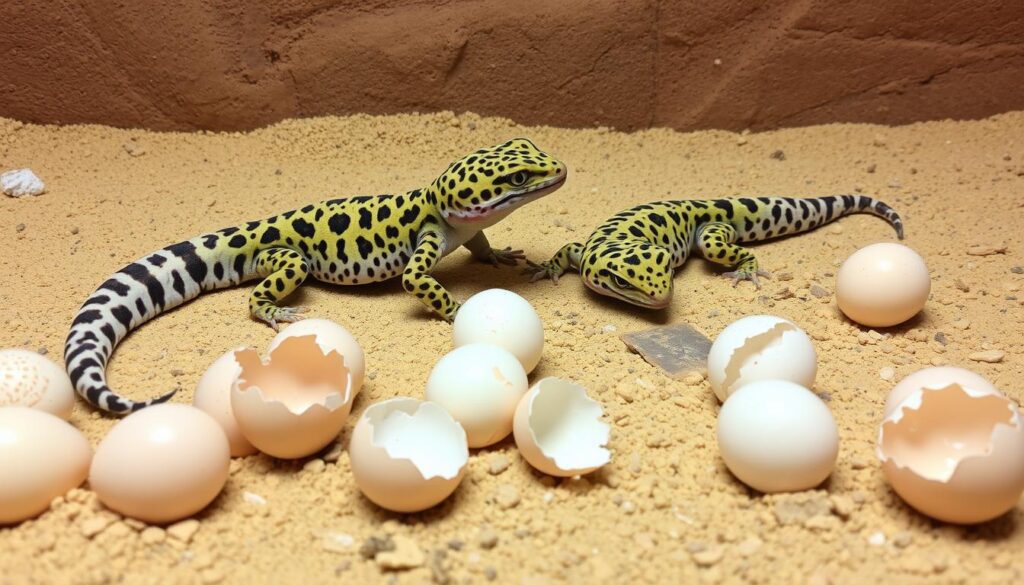
Knowing the key factors for a good breeding program is essential. This includes the right temperatures, humidity, and keeping stress low for pregnant females. Also, facing common challenges and getting vet advice can help a lot.
With the right knowledge and care, breeding leopard geckos can be very rewarding. It helps grow the number of captive-bred morphs and supports the conservation of this amazing species. Following this guide, new breeders can start a journey of successful and responsible breeding.
FAQ
When do leopard geckos typically lay eggs?
Leopard geckos lay eggs 2-5 weeks after mating. Females can have a clutch every 15-22 days. This usually happens from January to September.
What are the signs of an upcoming egg-laying event?
Look for visible eggs, less activity, and digging. Females might stop eating for up to a week before laying.
How often can a female leopard gecko lay eggs?
Females can lay eggs every 15-22 days for 4-5 months. First-time or older females might lay one egg. Others lay two.
What is the optimal breeding age for leopard geckos?
Leopard geckos should be at least 1 year old and fully grown. Females are ready to breed at 45 grams and 9-10 months old.
How can I prepare the enclosure for leopard gecko egg-laying?
Use a laying box that’s 6-7 inches in diameter and 4 inches tall. Fill it with moist peat moss, vermiculite, or Bed-A-Beast litter. Place it in a quiet spot in the enclosure.
What are the ideal incubation conditions for leopard gecko eggs?
Use containers with 1-2 inches of vermiculite or perlite mixed with water. Keep it humid but avoid water touching the eggs. The temperature affects sex: 80°F for females, 87°F for a mix, and 90°F for males.
What are some common challenges in leopard gecko breeding?
Challenges include infertile eggs, egg binding, and weak hatchlings. Make sure they eat well and get enough calcium. Also, keep the incubation conditions right for healthy hatchlings.


